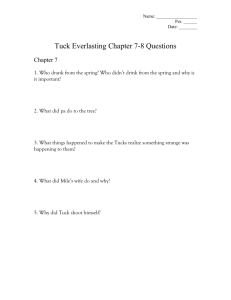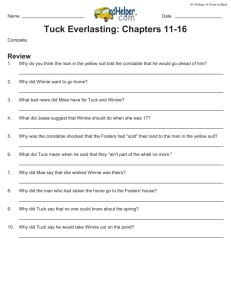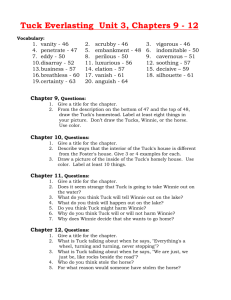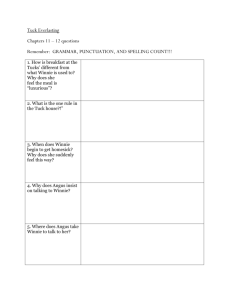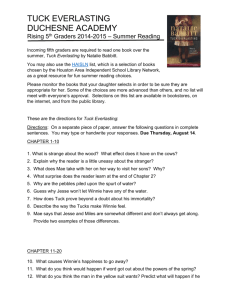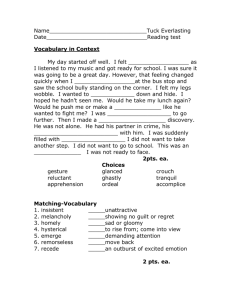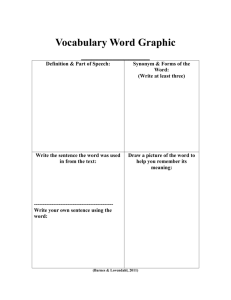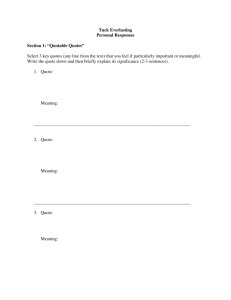Draft 1 Tuck Everlasting Unit
advertisement
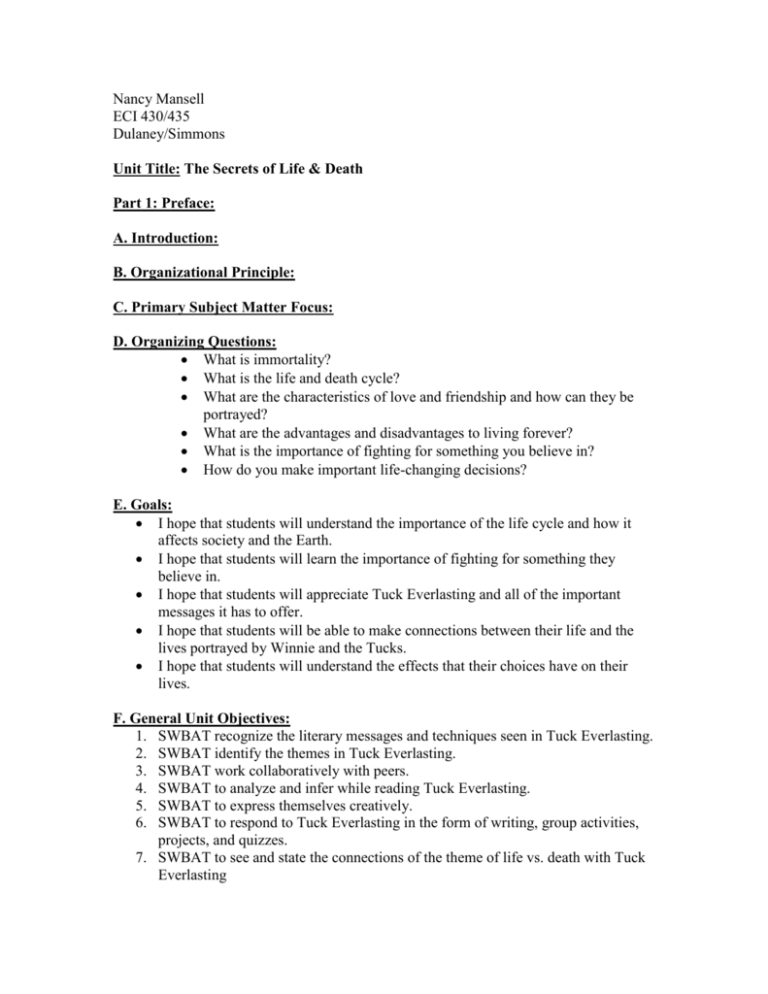
Nancy Mansell ECI 430/435 Dulaney/Simmons Unit Title: The Secrets of Life & Death Part 1: Preface: A. Introduction: B. Organizational Principle: C. Primary Subject Matter Focus: D. Organizing Questions: What is immortality? What is the life and death cycle? What are the characteristics of love and friendship and how can they be portrayed? What are the advantages and disadvantages to living forever? What is the importance of fighting for something you believe in? How do you make important life-changing decisions? E. Goals: I hope that students will understand the importance of the life cycle and how it affects society and the Earth. I hope that students will learn the importance of fighting for something they believe in. I hope that students will appreciate Tuck Everlasting and all of the important messages it has to offer. I hope that students will be able to make connections between their life and the lives portrayed by Winnie and the Tucks. I hope that students will understand the effects that their choices have on their lives. F. General Unit Objectives: 1. SWBAT recognize the literary messages and techniques seen in Tuck Everlasting. 2. SWBAT identify the themes in Tuck Everlasting. 3. SWBAT work collaboratively with peers. 4. SWBAT to analyze and infer while reading Tuck Everlasting. 5. SWBAT to express themselves creatively. 6. SWBAT to respond to Tuck Everlasting in the form of writing, group activities, projects, and quizzes. 7. SWBAT to see and state the connections of the theme of life vs. death with Tuck Everlasting 8. SWBAT recognize important events that happened during the time period of Tuck Everlasting NC Standard Course of Study Objectives: English Language Arts-Grade 6 Competency Goal 1: The learner will use language to express individual perspectives drawn from personal or related experience. Competency Goal 4: The learner will use critical thinking skills and create criteria to evaluate print and non-print materials. Competency Goal 5: The learner will respond to various literary genres using interpretive and evaluative processes. Social Studies-Grade 6 Competency Goal 3-Objective 3.03 Examine the development and use of tools and technologies and assess their influence on the human ability to use, modify, or adapt to their environment. Competency Goal 11-Objective 11.02 Examine the basic needs and wants of all human beings and assess the influence of factors such as environment, values and beliefs in creating different cultural responses. Common Core Standards: English Language Arts-Grade 6 Standard 1: Determine a theme or central idea of a text and how it is conveyed through particular details; provide a summary of the text distinct from personal opinions or judgments. Standard 2: Compare and contrast texts in different forms or genres (stories and poems; historical novels and fantasy stories) in terms of their approaches to similar themes and topics. Standard 3: Describe how a particular story or drama's plot unfolds in a series of episodes as well as how the characters respond to change as the plot moves towards a resolution. G. Possible Unit Materials & Supplementary Texts: *Tuck Everlasting *Ecclesiastes 3:1-8 (from King James Bible) *Fable (poem by Merrill Moore) Pushing Through Solid Rock (Poem by Nancy Wood) *The Weaver of Tomorrow (folktale by Jane Yolen) *The Water of Life (fairy tale by Wilhelm and Jacob Grimm) *The Water Cycle (By Walter Wick) *Excerpt from Voyages and Discoveries of the Companions of Columbus (historical nonfiction by Washington Irving) *Excerpt from Twilight Short story fiction: "Ponce de Leon and The Fountain of Youth" by Charles Morris *Movie Clip from "Tuck Everlasting" *Art: "The Fountain of Youth" by Lucas Cranach *Movie Clip from Twilight about living forever *Song-"Immortality" by Celine Dion *Song-"100 Years"-Foo Fighters *Song-If Tomorrow Never Comes"-Kent Blazy and Garth Brooks *Song-Turn! Turn! Turn!-The Byrds *Song-"Circle of Life"-Lion King *Song-"Just a Ride"-Jem H. Possible Activities/Instructional Strategies: Pre-reading questions about immortality Discussion of character, plot, setting, themes "Missing" Poster for Winnie "Wanted" Poster for The Tucks Create a comic strip on a scene in the novel Reading Response Journals every week Fountain of Youth-brief history, myth or fact? and then have students illustrate it Have students act out a scene in the novel Facebook page for a character in the novel Advertisement/Jingle for "The Eternal Life" Water Narrative/Journal from a character in the novel Rewrite the ending of the novel...if Winnie had drunk the water Write the story of the frog Create a collage representing a character in the book Crossword Puzzle of words from Tuck Everlasting A travel article and map on interesting places to visit in Treegap An investigative report abut a man's claim that he's found a toad that doesn't seem to age Water Cycle Diagram Character Notes/4R's chart filled out throughout reading Character Interview Winnie's Ever Changing Emotions Attitudes on Immortality Reciting a poem for extra credit Word Cloud Writing activity on Treegap in 2020 Letter from Winnie to her children about the Tucks Tuck Time Line-creating a time line from historical events during the the time period of the novel (1750-1950) Writing letters to Natalie Babbitt Character Sketch Create a CD for Tuck Everlasting Life Expectancy Activity I. Unit Map/Narrative Overview (15 class periods): Day 1: This lesson is the introduction to the unit theme of life vs. death. The primary focus of this lesson is to get students thinking about the idea of living forever. When students come into the classroom there will be images displayed on the overhead (characters from Twilights/Vampires, Infinity symbol, Ash tree, Circle of Life, Water). Teacher will lead students in a discussion on these pictures. I will pose questions: What do you know about these objects/ideas shown in these pictures? What do you think each picture represents? What do all of these pictures have in common? After the discussion, a question will be posed on the board: If you had a chance to stay young forever, would you want to? Why or Why not? Students will answer this in their journals in the form of a free write. Then, students will be grouped into groups of 4-5. They will come up with a list of advantages and disadvantages to staying young/living forever. After they do this, the group will pick a side (Yes for staying young forever, or no for staying young forever). Each group will then present their stance/argument to the class. Teacher will pass out a copy of Tuck Everlasting to each student. Ask students to make predictions on how they see living forever playing a part in the novel (in the form of an exit slip). Students are to read Prologue-Ch. 3 for homework (7 pages) and are to write a short paragraph in their Reading Response Journals about the assigned reading. Day 2: This lesson is focused on activating student thought and emotion on their reading of the prologue-chapter 3 of Tuck Everlasting. The primary focus of this lesson is to get students to make observations about the Winnie, the Fosters, and the Tucks, the setting, plot, and images mentioned in these first few chapters. This lesson connects to my theme because students will get a glimpse of the idea of the Tucks not aging in chapter 2. As an opening activity, students will be prompted to draw a picture of their favorite scene in the first few chapters (i.e. Winnie talking to the frog, Mae looking in the mirror to see the same woman that she has seen for 87 years). Students will volunteer to share their pictures and explain why they enjoyed that scene the most/what they learned from that scene. After this activity, I will lead the class in filling out a KWL chart on these first few chapters. This will engage students in a discussion on what they know from these chapters (characters, Treegap, Winnie’s plan to runaway, that the Tucks do not age). I will make the connection between yesterday’s assignment about staying young forever with the now known idea of the Tucks not aging. As an extension activity, I will have students create a “Map of Treegap” using the description of the town noted in Chapter 1. Students are to read Ch. 4-5 for homework (7 pages) and are to write a paragraph in their Reading Response Journal about their reactions/ideas to the assigned reading. Day 3: This lesson is focused on activating student thought and emotion on their reading of chapter 4-5 of Tuck Everlasting. The primary focus of this lesson is to get students to connect with Winnie and the idea of running away and to make inferences/predictions on the Ash tree and the spring. This lesson connects to my theme because students will be exploring the idea of living life and making decisions, and will make predictions on the spring. As an opening activity, students will engage in a “What’s Your Opinion?” Worksheet-Students will be given prompts (I wish my parents gave me more freedom, Talking to strangers is bad, Animals have thoughts and feelings just like humans, I would runaway if I was not happy at home, It is never good to always get what you want). Students will have to rate these prompts on a scale of 1-4, 4=strongly agree, 1=strongly disagree. They will also have to explain their answers in 2-3 sentences using personal experiences and evidence from the text. Students will share some of their ideas to their peers in the form of class discussion. Students will then create skits that reenact the scene where Winnie meets Jesse for the first time and when Ma and Miles find them talking near the spring (end of Ch. 5). Students will present their skits to the class. Students are to read Ch. 6 for homework and write in their Reading Response Journals. Students are instructed that before reading, they should predict in a paragraph why Ma Tuck was horrified at the fact that Winnie found the spring and said, “the worst is happening at last.” Day 4: This lesson is focused on getting students to understand the importance and trouble that the Tucks feel the spring holds. This lesson relates to my theme because it talks about life situations and decisions that people have to make to protect something. As an opening activity, students will respond to the following prompt in their journals: How would you feel if you were kidnapped like Winnie? Students will volunteer to share their answers to the class. Students will then create a “Missing” Poster for Winnie. They are to draw a picture for Winnie, state her name, age, family, where she lives, where she was last seen, who she was last seen with, reward, etc. Students will then post their posters around the room and the class will do a gallery walk. Students will vote on their favorite poster and that poster will be used in the class search to find Winnie. Students are to read Ch. 7 for homework. Day 5: When students come into class, there will be a bottle of water on their table. Students will be instructed to free write on the story of the spring/water that the Tucks tell Winnie about. I will lead the class in a discussion on this idea of a “Fountain of Youth.” I will present images and notes on the fountain of youth in the form of a Prezi or SlideRocket Presentation. Then students will read the story of Juan Ponce de Leon and the Fountain of Youth, located in the back of their texts. After reading, students are to create a comic strip of the fountain of youth. Students are to imagine that Juan Ponce de Leon went to Treegap and found the fountain and met the Tucks. The comic strip should demonstrate student knowledge of the Tucks story, Juan Ponce de Leon’s belief of the fountain, and the idea of eternal life water and the idea of staying young and living forever. Students are to read Ch. 8-9. Day 6: This lesson is focused on students learning about the water cycle and why water plays such an important role in the novel. As a class, popcorn style, students will read “The Water Cycle” by Walter Wick. From the reading, as a class we will create a list on the stages/characteristics water cycle and will then draw the water cycle together. This will tie Science into my unit. Then the teacher will prompt students to think about the life cycle. Students and teacher will create the life cycle and then students are to compare and contrast these two cycles as a table. Students are to read Ch. 10-11 for homework. Day 7: Students will engage in a free write: Describe a time when you were in an unfamiliar place: Where were you? How did you feel? Chapter 12 will then be read as a class (popcorn style). Students are to think back to the life cycle they created the day before. A discussion will be led where students make connections between Pa Tucks talk with Winnie about life with the life cycle. Students will engage in the “4 R’S Chart” (Recall: Draw a picture of the Tucks House described in Ch. 10, Relate: How does Pa Tuck describe life and death, Reason: Copy the most important quote that Pa Tuck said to Winnie during their conversation on the lake, Recreate: If Jesse was talking to Winnie about life on the lake instead of Pa Tuck, what would he say to her? Exit Slip: Do you agree or disagree with Pa Tuck and his idea that living forever is not a good thing? Why or Why not? Students are to complete “Winnie’s Ever Changing Emotions” Worksheet From chapters 1-12, students are to find Winnie’s changing emotions. This will serve as a review and informal assessment of the student’s comprehension so far. Day 8: Poem Activity: Students will come into class and two pictures would be displayed on the overhead: one would be a picture of baby, the other a picture of a headstone. I will prompt students to guess what the pictures represented. Students would engage in a free write on death. The prompt would be: Does everyone have to die? I will then have students read “Fable” as a class. Students would work in groups of 4 (at their table) to discuss the message of the poem-what the author was trying to say, symbols represented in the poem, how the poem relates to Tuck Everlasting. Groups would then volunteer their findings to the class. Writing Assignment: Students will create their own poem on life and death. Prompt: Now that you have read “Fable” by Merrill Moore, write a poem on how you see about life and death. To help you brainstorm ideas, as a group, make a pros and cons list on living forever, and a list on dying. Choose 2-3 ideas from your each of your lists to incorporate into your poem. As a closure I will tell students that they are to finish their poems if they have not for homework and that they will have a chance to share them in class tomorrow. To continue on to this lesson, the next class period, teachers will connect “Fable” and the poems that they have written to Tuck Everlasting. Students are to read Ch. 13-15 for homework. Day 9: Students will volunteer to share their poems that they wrote yesterday. I will have students share how “Fable” and their poems relate/connect to Tuck Everlasting. To introduce the chapters that students read in class, students will engage in a free write: Describe a time when you felt cared for/loved by someone other than your parents. Relate your experience to Winnie’s experience of feeling cared for by the Tucks described in Ch 14 on page 38. To discuss chapters 13 and 15, students will then be given a character map/outline. They are to draw the “man in the yellow suit” and are to write words/actions outside of his picture that describes his characteristics, what he does during these chapters, and then are to make predictions of why he wanted to the buy the Wood. Students are to read Ch. 16-17 for homework. Day 10: Class discussion on what students thoughts about the man in the yellow suit taking the police to the Tucks house to arrest them for kidnapping Winnie. I will then introduce students to the song activity. Students will listen to 5-7 songs that deal with life/immortality. Each group will then be assigned a specific song and they will become experts on that song. They will analyze it and how the lyrics and images of the song represent ideas seen in Tuck Everlasting. As a group students will write their own song that relates to life/death/living forever based on the conversation between Miles and Winnie seen in Ch. 17. Next class period, students are going to finalize their songs and are to create dance moves to go along with their song. Students will present their music videos to the class and they will be filmed Day 11: Students will work on their music videos of the Tuck Everlasting song that they created. They will finalize it and come up with dance moves/props to go along with their song. Then each group will sing their song and will be filmed. Students will read ch. 18-19 for homework. Day 12: Students will create an advertisement/Jingle for the “The Eternal Life Water” that the man in the yellow suit was going to sell. Students will create a poster and song for their water and will present them to the class. Day 13: Students will examine products in today’s society that promote stopping the aging process. Students will read ch. 20-21 for homework Day 14: Class debate: Should Mae Tuck be hanged at the gallows? Class will be split it up and will debate this topic. Students will have time to plan out their argument first. Day 15: Tuck Timeline: students will learn about important events during the time period of the novel. 1793-1880’s. Each group will be given an important event to research. Class will create an interactive timeline using timeline X. Each group will add their event to the timeline. Students will read Ch. 22-23 for homework. Day 16: Students will conduct a character interview with Winnie. They are to write a narrative where they as Winnie how she feels to be home, if she misses the Tucks, how she feels about the Tucks, how she is going to help Maw Tuck escape the gallows. They will do this in pairs. Students will read Ch. 24-25 for homework. Day 17: Students will create a “Wanted” Poster for Mae Tuck. Students will also free write on Winnie’s decision to pour the water on the toad? Why did she do it? Will she drink the water and be with Jesse? Day 18: Students will read “The Weaver of Tomorrow” in class. They will create a bubble map comparing and contrasting the story to Tuck Everlasting. How was the weaver like Winnie? Would Winnie not want to know the future like the weaver? Would Winnie stay mortal? Students will read the prologue for homework. Day 19: Students will respond to Treegap in 2020 prompt. What do you think Treegap will look like in 2020? Consider housing, transportation, industry, law enforcement, food, shopping, natural areas, recreation. Then students will write a letter pretending to be Winnie writing to her children about the Tucks. They are to finish this assignment for homework. Day 20: Life Expectancy Activity-Students will look at life expectancies of different countries and compare and contrast them. Day: Twilight Day: Brown Bag Assessment Wordle in class Final Project: Students pick one: Facebook Page or Collage of a Character along with a Bio Poem A travel article/brochure and map of Treegap A CD for Tuck Everlasting A Children’s Book of the story of the frog (must include pictures along with the words) Part II: The Daily Lesson Plans Plan # 1 of 15 [55-minute class period] Context: This plan is part of my larger unit focusing on the theme of life and death, and the ideas of immortality and friendship. In this lesson, students will view images related to life and immortality and make observations and connections with these images. Students will also be engaged in a group discussion on the pros and cons of staying young forever. They will practice their speaking skills by arguing a side of the topic to their classmates. Specific Learning Objectives: SWBAT: [Cog] 1. Observe the messages of life and immortality represented in presented images 2. Recognize the difference between living forever and dying 3. Develop the pros and cons of staying young forever [Aff] 4. Collaborate effectively with their peers during the group activity 5. Connect the prompt with a personal experience [Perf] 6. Create a pros and cons list to staying young forever 7. Create an argument for staying young forever 8. Present their argument to their peers 9. Write a response to the prompt [ELA NCSCOS] Grade 6: 1.01 Narrate an expressive account which: establishes the significance of an event and uses remembered feelings and specific details. Grade 6: 1.02 Explore expressive materials that are read, heard, and/or viewed by: comparing and/or contrasting information, drawing inferences and/or conclusions, and determining the main idea and/or significance of events. Grade 6: 1.03 Interact appropriately in group settings by: listening attentively, and contributing relevant comments connecting personal experiences to content. Materials/Technology Resources Needed: Slideshow of life/immortality images Prompt/Pros & Cons Outline Worksheet References/Sources: These are noted throughout the plan (and on unit Works Cited Page). Procedures/Instructional Strategies: I. Bridge [5 minutes] As students come into the classroom there will be images displayed on the projection screen (characters from Twilights/Vampires, Infinity symbol, Ash tree, Circle of Life, Water). Teacher will lead students in a discussion on these pictures. In a full group discussion I will pose these questions: What do you know about these objects/ideas shown in these pictures? What do you think each picture represents? What do all of these pictures have in common? I want to encourage students to: Make the connections between the pictures and life/and or immortality Explain how these pictures symbolize life II. Steps of Activity 1) First, students will be given the following prompt: If you had a chance to stay young forever, would you want to? Why or Why not? They will free write a short response to this question as the first entry to their Reading Response Journals [5 minutes]. [Ref: My own idea, prompt comes from the Glencoe McGraw-Hill Study Guide for Tuck Everlasting] 2) Following the response writing, students will gather with their tables (4-5 students) and discuss their ideas on the prompt [5 minutes]. 3) As a group, students will create a pros and cons list to the idea of staying young/living forever based on their free writes and other ideas that arise during group discussion. The group will be given an outline to create their lists. I will walk around the room, listening to each group’s ideas and prompting them with questions if needed [10 minutes]. 4) After creating their pros and cons list, each group will choose a side of the argument (Yes, I would stay young because…. Or No, I would not stay young because….). They are to formulate their argument in the following fashion on a given worksheet: State their side, state why (at least 5 reasons), state what they would do if they could stay young forever, and address the opposing side of the prompt [10 minutes]. 5) After groups formulate their argument, each group will present their argument and reasoning [15 minutes]. 6) After the groups present, I will bring this activity to a close by summing up the student’s ideas on the idea of living forever. I will then pass out a copy of Tuck Everlasting to each student. I will ask students to list three things that they would do if they could stay young forever and would have them make predictions on how they see living forever playing a part in the novel (in the form of an exit slip) [5-7 minutes]. Closure: Give students the following directions for preparing for tomorrow’s class: Please read the Prologue through Ch. 3 for homework. It is not too much, only 7 pages of reading. After reading, I would like for you to write a short paragraph in your Reading Response Journal on your reaction to these first few chapters. You may answer questions like: What characters do you meet in the first chapters? What is happening in the first few chapters? Do you like the book so far? Why? Accommodations/Differentiation/Special Needs: None needed for this particular plan. Methods of Evaluation: (with the specific objectives which they evaluate indicated) Students’ Free Writes on the prompts in their Reading Response Journals [1.01, 9, 5] Student Response during class discussion on Images [1.02, 1] Group Pros & Cons List [1.02, 1.03, 3, 4, 6] Group Argument Worksheet and Presentation [1.03, 7, 8] In Retrospect: Will complete here when the lesson is finished. When reflecting I will probably answer the following questions: What are the strengths of my lesson? What are the weaknesses of my lesson? Did my lesson engage my students? Did my students meet the lesson objectives? How could I modify this lesson to make it more effective?
